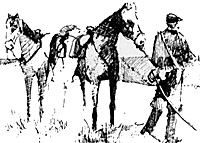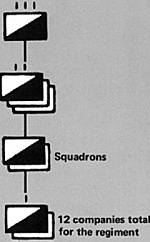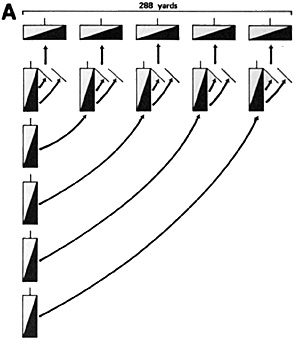 No army can enter the lists with a fair chance of success unless it has a cavalry that can both ride and fight.
No army can enter the lists with a fair chance of success unless it has a cavalry that can both ride and fight.
Beginning with but 4,000 cavalrymen in 1861, the armies of the Civil War were to demand a higher complement of cavalry as the war continued. The cavalry was often called upon to picket, raid and even dismount and fight like infantry. In order to accomplish the great task assigned to it, the U. S. cavalry forces alone were to grow to 80,000 organized sabers near the end of the war. Like the wars of the early nineteenth century, such large amounts of cavalry were needed. However, the uses of cavalry were to be very different in these two wars.
During the wars of the early nineteenth century, the saber was often considered to be the most effective weapon carried by the cavalryman. With the exception of the Dragoons, great emphasis was placed on mounted shock attacks on the enemy in massed formations. The heavy cavalry was later armed with sabers and with some light armor for protection in the melee that was desired by the Napoleonic cavalry.
Usually the cavalry would approach from a walk to a gallop until they reached musket range. Upon entering the last 100 yards, the horses were put into a full run. The one volley from the infantry was absorbed and the issue was put to the saber. With their short-range muskets, the infantry frequently formed into massed squares for protection from the horde of cavalry that often got through the one volley.
With the coming of the rifle-musket, the saber charge often became too costly. With the added range came more time to load and, consequently, more volleys could be delivered. In the Civil War this meant an attacking cavalry force taking the infantry frontally could expect not one, but three murderous volleys. This too often meant the saber charge was repulsed before the infantry was assaulted. (To the writer's knowledge, the infantry formed squares against a cavalry melee only once in the Civil War.)
 At right, the Union organization pictured here was the ideal. Very often only two battalions were attached to a regiment and the strength after prolonged campaigning might be less than half what is listed. The two units that formed the battalion were called squadrons. The Confederate regiment consisted of two squadrons of two companies each. The strength of the Confederate regiment varied greatly from its allotted 650 effectives to as low as 100 by 1865.
At right, the Union organization pictured here was the ideal. Very often only two battalions were attached to a regiment and the strength after prolonged campaigning might be less than half what is listed. The two units that formed the battalion were called squadrons. The Confederate regiment consisted of two squadrons of two companies each. The strength of the Confederate regiment varied greatly from its allotted 650 effectives to as low as 100 by 1865.
Breaking the European mounted tradition was the partisan cavalry, which rarely accompanied an army or wielded a saber. Unlike conventional cavalry, they often operated alone behind enemy lines. Their success was based upon an intelligent blending of speed, surprise and aggressiveness when engaging superior numbers.
Morgan
In 1862, near Kentucky, General John Morgan of the Confederate Army assembled a cavalry force that resembled mounted infantry more than cavalry. Many of his riders were "born in the saddle" and were expert marksmen. Determined to make use of both of these qualities, Morgan organized his minature army into a self-sustaining outfit complete with two small howitzers for support. When his force was organized and equipped, the tiny command drove deep into the enemy's rear in Kentucky.
Once behind the Union Army, the tiny command produced utter chaos in the Union's supplies. Riding 300 miles in eight days, Morgan's command destroyed railroad bridges and captured supplies. He was also to pin down large numbers of troops who were both chasing and guarding against him. The interruption in the Union supply line was so great it was a key factor in the Union commander's decision to withdraw.
When forces were sent in pursuit of Morgan's small army, they constantly found themselves a little too late to catch him. The little force was mounted and simply moved too fast for any unit large enough to defeat him. Whenever a small pursuit force or an isolated garrison did confront the raiders, they found themselves facing a stubborn and determined foe.
Adjustment to the rifle-musket manifested itself in the increased emphasis upon engagements of large units of dismounted cavalry. Fortunately for the regular cavalry, the terrain and improvements in carbines were to aid this change.
Before the Civil War the innovations in firearms had affected the cavalrymen's carbine even more than the infantry's musket. Breech-loading carbines were common in the Union Army almost from the start of the war. The breech-loading system meant that the carbine could be fired faster and with greater ease while lying down. The breech-loading carbines could be handy on the skirmish line for these reasons. Only their limited range of around 100 yards was a drawback that tended to outweigh the advantages of the breechloader.
By 1863 some Union cavalry were receiving repeating carbines which, under the right conditions, could dominate the infantry. A Confederate said, "The head of the column as it pushed on by those behind appeared to melt away or sink into the earth. For although continually moving, it got no nearer." Whenever the infantry did come to close combat with the cavalry, the cavalryman often found himself blessed with the highly effective six-shooter. Even though the six-shooter's accuracy was poor, nevertheless, it could be an asset at close quarters in moments of need. A few Confederate irregulars of Morgan's command went so far as to shorten a few double-barrel shotguns. This weapon was particularly effective when fired point-blank into unfortunate Union infantry.
Along with the innovations in cavalry weapons, the terrain was an aid to the cavalry. At first it was thought that the wooded wilderness, over which the Civil War was fought, would be disadvantageous to the cavalry. It might have been had cavalry adhered to the old shock tactics of Napoleon. However, with the carbine's limited range, the terrain was to force skirmishes that were closer together -- no small advantage for the cavalrymen and their powerful and short-ranged weaponry. The terrain and the firearms also allowed the regular cavalry to adopt new tactics that influenced the conduct of the war a great deal. One of the most interesting innovations was the adaptation and improvement in raiding tactics.
The Raid
The idea of passing cavalry through the enemy's rear was not new. Indeed, Hadick had made a raid in the Seven Years' War in which Berlin was captured. However, the cavalrymen of the Civil War were to bring a new concept to the art that was to make it a primary weapon of nineteenth century warfare.
Starting with Stuart's ride around the army of the Potomac in 1862, the raids increased in boldness and size. By 1863 the Union had adopted the raid and used it to great advantage themselves. Benjamin Grierson's cavalry left La Grange, Tennessee, and rode 300 miles to Baton Rouge. In route, Brierson plunged through the rear of the Confederate Army, wrecked communications and forced the detachment of the Confederate cavalry for pusuit. General Grant stated that the raid was of great importance because the enemy's attention was drawn away from his efforts at Vicksburg.
But the cavalry raid could often fail. In April, 1863, a brigade of Union cavalry succeeded in destroying a southern railroad and then were easily rounded up and captured by the Confederates. Another failure was that of choosing the wrong target, which would be of little value. Stuart's raid at Gettysburg, although well executed, was barren of direct results. The most common error made was that the destruction of the target was not thorough enough. In Kilpatrick's raid against the Macon railway in 1864, the railway was destroyed in four days and repaired in only two days.
Dismounted Fighting
Along with the raiding tactics, the cavalry's role upon the battlefield was in a transition period. No longer was the cavalryman always mounted while in battle. He was often called upon to fight dismounted as well as mounted. Even when directly confronted by hostile cavalry, the trooper dismounted to engage. At Brandy Station on June 9, 1863, mounted cavalry attacked both mounted and dismounted cavalry. Yet, at one point, two brigades met saber to saber in a simultaneous charge.
This action was not limited to hostile cavalry. During the final pursuit of Lee, Sheridan's cavalry dismounted and engaged the infantry rearguard under Ewell. Pinning the infantry in a firefight, Sheridan pushed three cavalry divisions rapidly around Ewell's flank into his rear. Meanwhile, Sheridan had hastened forward the VI Corps which arrived and opened a strong fire upon Ewell. With the fire of the infantry to his front and the dismounted cavalry to his rear, Ewell found himself compelled to surrender.
Often Morgan would dismount and deploy in force into a long concave skirmish line with the flanks bending toward the enemy. When the enemy closed, they frequently found themselves partially enveloped and under an effective converging fire. Many times this meant that the pursuit force was overpowered and forced to retreat. Any attempt to flank the raiders met with similar effect because the skirmish line had mounted companies deployed on the flanks directed to delay the enemy's attack. Once delayed, the main body would remount, ride to the area under attack, dismount and confront the enemy again.
The tactics of this band of cavalry was unconventional to say the least. In addition to fighting on foot, Morgan's men spurned the saber. On one occasion, the partisans laughingly said, "Here, boys, come those fools with the sabers again."
Later in the war, Nathan B. Forrest copied Morgan's style but added more cavalry and more daring raids. In 1864, while Sherman advanced upon Atlanta, he was under constant harassment from Forrest. Two expeditions sent to rout Forrest received rough treatment and were repelled effectively. After the fall of Atlanta, Sherman had no less than four infantry divisions guarding his communication lines in Tennessee. Finally, utterly frustrated by Forrest's raids, Sherman wrote, "Forrest is the very devil. There will never be peace in Tennessee until he is dead."
 Cavalry evolutions were even more involved than the infantry's. More bugle calls were used and the horses and men had to be raised to drill precision before they could be effectively employed.
Cavalry evolutions were even more involved than the infantry's. More bugle calls were used and the horses and men had to be raised to drill precision before they could be effectively employed.
(A) is a regiment of five squadrons deploying from road column into line of battle.
(B) is the standard cavalry squadron of the Union Army up to strength.
The numbers represent:
- 1. and 5. Lieutenants;
3.Captain commanding;
2. and 4. 2nd Lieutenants;
10. 2nd Captain;
6-9,11. Sergeants
 Note how the system made it difficult to leave the ranks without permission.
Note how the system made it difficult to leave the ranks without permission.
In the east, John S. Mosby followed the tactics of Forrest and Morgan with one final touch. As with other partisan cavalry, Mosby caused a great deal of destruction to Union communications and he tied down a good number of troops. Unlike the other two when hotly pursued by the Union troopers, Mosby would merely disperse his partisans into the citizenry of Virginia. When the Union pursurers arrived all they could find were peaceful families. Although Mosby's style may sound more Viet Cong than cavalry, nevertheless it was quite effective and very frustrating to the Union commanders.
The terrain together with the increasing power of the rifle-musket and carbines forced the cavalry to operate less like the heavy cavalry of Napoleon and more like mounted infantrymen. Because of the rifle-musket, the saber charge was becoming outmoded. The dismounted trooper with his carbine was beginning to change war. The doctrine of cavalry was changing because of the new firepower. Utilizing such firepower, even small bands of partisan cavalry could be formidable with the new rifled arms. However, the cavalry was not alone in feeling the punch of the new firepower. The artillery was greatly affected as well.
More ACW Rifle-Musket
-
ACW: Introduction
ACW: Infantry
ACW: Infantry Tactics (Examples)
ACW: Cavalry
ACW: Artillery
ACW: Engineers
ACW: Entrenchments
ACW: Grand Tactics
ACW: Tactics: Auerstadt 1806 vs. New Market 1864
ACW: Conclusion and Bibliography
Back to Conflict Number 7 Table of Contents
Back to Conflict List of Issues
Back to MagWeb Master Magazine List
© Copyright 1974 by Dana Lombardy
This article appears in MagWeb (Magazine Web) on the Internet World Wide Web.
Other military history articles and gaming articles are available at http://www.magweb.com